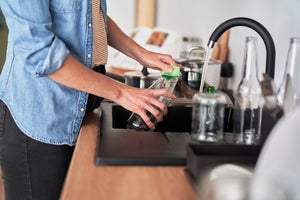Yes, water bottles get dirty (even if you only use them for water, and especially if they are well-loved).
Cleaning water bottles extends their life, but it involves more than just rinsing them out. You need to scrub them properly, completely remove any lingering moisture, and keep them dry in between uses.
The good thing about Reduce water bottles is that they’re built to last! They can take a beating and are surprisingly easy to clean.
Keep reading to find out how to clean a reusable water bottle properly, restoring it to its original shine.
Germs Love Water Bottles Almost As Much as You Do
Germs (like common viruses and bacteria) love moist, wet environments. Reusable water bottles are the perfect place for bacteria to thrive. They’re wet, and water bottles with lids create a warm, damp, and dark environment that’s the perfect breeding ground for all sorts of germs.
How many germs, you ask? If you really want to know, a small-scale study performed on four styles of plastic water bottles found that slide-top bottles contained 933,340 CFU/sq cm (colony-forming units, the measurement for living bacteria cells). In comparison, the average screw-top water bottle contained 159,060 CFU/sq cm.
The water bottles that tested the highest held water or moisture in a location without the ability for the water to evaporate. Straw-topped water bottles, like our Cold1 Mugs, had the lowest concentration of bacteria and viruses (in the study, similar straw-top bottles contained a mere 25.4 CFU/sq cm). This was probably because the straws dried quickly.
Water bottles with screw-top lids typically contain hundreds of thousands of colony-forming units, but Reduce took a different approach to make our water bottles safer.
Reduce Hydro Pure water bottles have a copper lid that naturally repels bacteria and keeps your water bottle safer to use.
Everyday Cleaning
Taking care of your water bottles every day is a very simple task that pays off. Your bottles will last longer and you’ll stay healthier.
Use Soap and Lukewarm Water
Use a clean sponge or bottle brush to scrub deep inside your water bottle with soap and lukewarm water. You don’t have to use boiling-hot water to kill germs; dish soap and warm water should do the trick.
Make sure that you’re using a clean sponge. Dirty sponges are a breeding ground for bacteria and could introduce more germs to your water bottle.
Dry Them Completely
After you wash your water bottles, let them dry completely. If you’re in a rush to use your water bottle again, place a dry towel on the end of a wooden spoon and dry the inside. If you have time, just let the water bottle air-dry with the lid off.
All of our water bottles are dishwasher safe, too. Remove all the lids and parts and place them on the top rack. It’s still a good idea to dry your water bottle completely after you remove it from the dishwasher.
For Heavy-Duty Cleaning
Have you ever forgotten a drink, unscrewed the lid, and realized it needed more than a simple rinse? It happens to the best of us. Thankfully, there are a few different things you can do to restore your water bottle back to its like-new state.
1. Soak in Boiling Water
If your water bottle is particularly smelly or has really difficult stuck-on bits, remove all the pieces and soak it in boiling water overnight. To do this, boil some water in a large pot. Then, remove the pot of water from the heat and place your water bottle inside.
The next morning, grab your water bottle and hand wash it with soap. Give it a light sniff. If it still has a slight odor, soak in either baking soda solution or white vinegar.
2. Soak in White Vinegar
Vinegar is an astringent and removes odor-causing bacteria. The best way to use vinegar to deep clean your water bottle is to fill it to the top with white vinegar.
It’s okay to dilute the vinegar with water, but try to use as much vinegar as you can.
The next morning, rinse out the vinegar and wash it by hand with soap and water. It shouldn’t have a vinegar smell, but if you think you can still smell the vinegar, soak it overnight in boiling water. After this it should smell like new.
3. Soak in Baking Soda Solution
Baking soda is a natural deodorizer. Add two heaping teaspoons into your water bottle and fill the rest of it with warm water. Give it a nice stir and then let it sit like this overnight.
The next morning, wash your reusable water bottle with soap and water. If you think it still has lingering odors, add some vinegar and let it sit for a few hours. The vinegar should remove the last traces of odor from your water bottle.
Don’t use vinegar and baking soda together. This creates a chemical reaction that could damage your water bottles if you don’t rinse out the mixture fast enough.
Hand-Washing Is Best, but the Dishwasher Works, Too
Knowing how to clean a reusable water bottle is key to making it last. Rinse them out every night and dry them completely. Hand wash to remove odor-causing bacteria as often as you can.
Don’t forget - all Reduce water bottles are top-rack dishwasher-safe. All you have to do is remove the lid, place them in the top rack, and let your dishwasher do the hard work!
Check out our complete line of insulated cups and reusable water bottles that are easy to clean and naturally antimicrobial, too!
